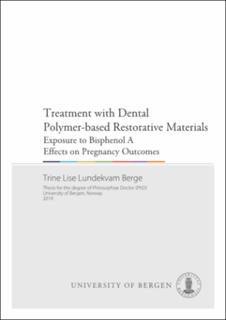| dc.contributor.author | Berge, Trine Lise Lundekvam | en_US |
| dc.date.accessioned | 2020-02-12T08:25:09Z | |
| dc.date.available | 2020-02-12T08:25:09Z | |
| dc.date.issued | 2019-10-18 | |
| dc.identifier.isbn | 9788230861974 | en_US |
| dc.identifier.uri | https://hdl.handle.net/1956/21399 | |
| dc.description.abstract | Dental polymer-based materials have become the first choice for restorative treatment in many countries, and the increased use of these materials over the last decades has raised questions about their biological safety. It has been shown that monomers as well as contaminants can leak from dental polymer-based restorations. Due to its estrogenic effect, bisphenol A (BPA) has been considered as a compound of specific interest. Exposure to BPA during early developmental stages of life is of particular concern. Large epidemiological studies exploring whether placement of dental polymer-based restorative materials in pregnant women is associated with increased risk for the fetus are warranted. The overall aim of the present work was to gain knowledge about the exposure to BPA from dental polymer-based restorations in humans and to investigate whether placement of polymer-based dental fillings during pregnancy is associated with increased risk for adverse birth outcomes. The thesis comprises three studies. In the first study, 20 individuals with six or more tooth surfaces filled with polymer-based materials (composite group) and 20 individuals without dental polymer-based materials (comparison group) were enrolled. Saliva was collected to assess if presence of dental polymer-based fillings is associated with increased salivary BPA level. In the second study, 20 patients who were scheduled for treatment of at least two tooth surfaces with dental polymer-based restorative material were included. Saliva and urine were collected before and up to one week after treatment to assess if placement of dental polymer-based material is associated with increased BPA concentrations in saliva and urine. The BPA concentration in the biological samples was determined using liquid chromatography/mass spectrometry. Presence of dental polymer-based fillings was associated with slightly higher concentration of BPA in saliva. Directly after treatment with dental polymer-based material, there was a considerable increase in the concentration of BPA in saliva. After the initial increase, the concentration decreased exponentially over time. One week after treatment, the salivary BPA level was only marginally higher compared to the pretreatment level. In urine, no statistically significant change of BPA concentration after placement was observed. In the third study, data from the large Norwegian Mother and Child Cohort Study was used to investigate if placement of white fillings during pregnancy was associated with increased risk for adverse birth outcomes. The results indicated that there was no statistically significant increased risk for adverse birth outcomes for participants who had white fillings placed during pregnancy compared with women who did not consult a dentist during pregnancy. In conclusion, dental polymer-based restorative materials might contribute to BPA exposure in humans. However, the exposure appears to be relatively short and transient. Women participating in the Norwegian Mother and Child Cohort Study who received dental polymer-based restorations (white fillings) during pregnancy had no increased risk for adverse birth outcomes including stillbirth, malformations, preterm birth, and low or high birth weight. | en_US |
| dc.language.iso | eng | eng |
| dc.publisher | The University of Bergen | eng |
| dc.relation.haspart | Paper I: Berge TLL, Lygre GB, Jönsson BAG, Lindh CH, Björkman L. Bisphenol A concentration in human saliva related to dental polymer-based fillings. Clinical Oral Investigations. 2017;21(8):2561-8. The article is not available in BORA due to publisher restrictions. The published version is available at: <a href="https://doi.org/10.1007/s00784-017-2055-9" target="blank">https://doi.org/10.1007/s00784-017-2055-9</a> | en_US |
| dc.relation.haspart | Paper II: Berge TLL, Lygre GB, Lie SA, Lindh CH, Björkman L. Bisphenol A in human saliva and urine before and after treatment with dental polymer-based restorative materials. European Journal of Oral Sciences. 2019; 127(5):435-444. The article is available at: <a href="http://hdl.handle.net/1956/21398" target="blank">http://hdl.handle.net/1956/21398</a> | en_US |
| dc.relation.haspart | Paper III: Berge TLL, Lygre GB, Lie SA, Björkman L. Polymer-based dental filling materials placed during pregnancy and risk to the foetus. BMC Oral Health. 2018;18(144). The article is available in the main thesis. The article is also available at: <a href="https://doi.org/10.1186/s12903-018-0608-1" target="blank">https://doi.org/10.1186/s12903-018-0608-1</a> | en_US |
| dc.title | Treatment with Dental Polymer-based Restorative Materials. Exposure to Bisphenol A Effects on Pregnancy Outcomes | en_US |
| dc.type | Doctoral thesis | |
| dc.rights.holder | Copyright the author. All rights reserved | |
| dc.identifier.cristin | 1738492 | |
